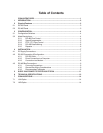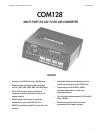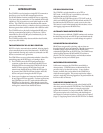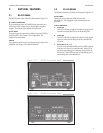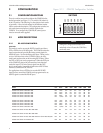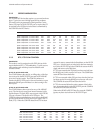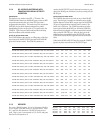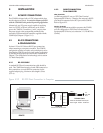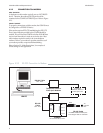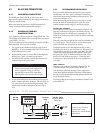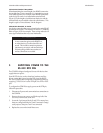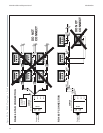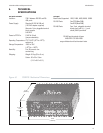
COM128 Installation and Operation Manual Schneider Electric
6
3.2.4 RS-485 DATA BUFFERING WITH
TRANSMISSION DELAY AFTER RTS
ASSERTION
APPLICATION
This mode is very similar to the RTS / CTS mode. The
COM128 buffers data from the RS-485 ports, asserts its RTS
output then transmits data out of the DTE port after a
programmable time delay. This mode is used in conjunction
with DCE devices which require hardware flow control
(handshaking) but do not provide a CTS signal back to the
COM128. Typical uses are radio modems and multi-drop
lease line modems with switched carriers.
RS-232 TO RS-485 DATA FLOW
The COM128 detects the start bit, or falling edge, of the first
byte received by the RS-232 DTE port and sets all 4 RS-485
ports into Transmit mode. The COM128 continues to
Mode Port Baud SW1 SW2 SW3 SW4 SW5 SW6
RS-485 Data Buffering with 20 mSe c transmission delay after RTS assertion DTE 1200 OFF OFF OFF OFF OFF ON
RS-485 Data Buffering with 50 mSec transmission delay after RTS assertion DTE 1200 ON OFF OFF OFF OFF ON
RS-485 Data Buffering with 100 mSec transmission delay after RTS assertion DTE 1200 OFF ON OFF OFF OFF ON
RS-485 Data Buffering with 20 mSec transmission delay after RTS assertion DTE 2400 ON ON OFF OFF OFF ON
RS-485 Data Buffering with 50 mSec transmission delay after RTS assertion DTE 2400 OFF OFF ON OFF OFF ON
RS-485 Data Buffering with 100 mSec transmission delay after RTS assertion DTE 2400 ON OFF ON OFF OFF ON
RS-485 Data Buffering with 20 mSec transmission delay after RTS assertion DTE 4800 OFF ON ON OFF OFF ON
RS-485 Data Buffering with 50 mSec transmission delay after RTS assertion DTE 4800 ON ON ON OFF OFF ON
RS-485 Data Buffering with 100 mSec transmission delay after RTS assertion DTE 4800 OFF OFF OFF ON OFF ON
RS-485 Data Buffering with 20 mSec transmission delay after RTS assertion DTE 9600 ON OFF OFF ON OFF ON
RS-485 Data Buffering with 50 mSec transmission delay after RTS assertion DTE 9600 OFF ON OFF ON OFF ON
RS-485 Data Buffering with 100 mSec transmission delay after RTS assertion DTE 9600 ON ON OFF ON OFF ON
RS-485 Data Buffering with 20 mSec transmission delay after RTS assertion DTE 19,200 OFF OFF ON ON OFF ON
RS-485 Data Buffering with 50 mSec transmission delay after RTS assertion DTE 19,200 ON OFF ON ON OFF ON
RS-485 Data Buffering with 100 mSec transmission delay after RTS assertion DTE 19,200 OFF ON ON ON OFF ON
Mode Port Baud SW1 SW2 SW3 SW4 SW5 SW6
Repeater NA 1200 ON ON OFF OFF ON ON
Repeater NA 2400 OFF OFF ON OFF ON ON
Repeater NA 4800 ON OFF ON OFF ON ON
Repeater NA 9600 OFF ON ON OFF ON ON
3.2.5 REPEATER
For use as a RS-485 repeater. It is a 1 to 3 repeater with Port
A as a "master" port and Ports B, C, and D as slaves. Ports
B, C, and D do not share data. The RS-232 ports are not
used. That is, port A can transmit to B, C, and D, and ports
B or C or D can transmit to A.
monitor the RS-232 DTE port for data and continues to pass
data to the RS-485 port until there is no data coming into the
RS-232 port.
RS-485 TO RS-232 DATA FLOW
The COM128 detects data received on any of the 4 RS-485
ports. The first byte is stored in an internal memory buffer
and the Request To Send (RTS) output signal of the DTE RS-
232 port is asserted and an internal timer is started. The
buffer size is 256 bytes. The COM128 continues to buffer
bytes received from the RS-485 port. When the COM128's
internal timer has elapsed it starts to transmit the buffered
data out the RS-232 DTE port. After the last byte in the
buffer has been transmitted out the RS-232 DTE port the
COM128 de-asserts the RTS signal and returns to the Idle
State.
When in the RS-485 to RS-232 Data flow state the COM128
ignores any data received from its' RS-232 DTE port.





